Tired of inbox overload? Discover our roundup of the best alternatives to email for team chat, task management, and streamlined collaboration in 2025.
October 2, 2025 (2mo ago)
7 Powerful Alternatives to Email to Use in 2025
Tired of inbox overload? Discover our roundup of the best alternatives to email for team chat, task management, and streamlined collaboration in 2025.
← Back to blog
It’s a familiar story: you open your laptop to tackle a big project, only to get swallowed by an endless stream of emails. Urgent requests, buried attachments, and confusing CC threads turn your inbox into a productivity black hole. Email has been the cornerstone of business communication for decades, but its limits are getting pretty obvious in today's fast-paced, collaborative world.
Constant interruptions, a lack of transparency, and the sheer volume of messages are costing teams valuable time and focus. Even simple things, like requesting annual leave via email, can add to the clutter, creating annoying administrative loops that drain efficiency. The good news is that we're in a golden age of communication tools built to break this cycle.
This guide dives into seven powerful alternatives to email** designed to help you regain control. From real-time chat platforms like Slack and Microsoft Teams to smart, AI-driven task managers like Fluidwave, we'll cover solutions for just about every team’s needs. Each review is set up to give you a clear, actionable overview, complete with screenshots and direct links to help you decide.
We’ll look at how these tools solve specific email headaches, offer some practical tips for making the switch, and help you find the perfect fit to create a more organized and efficient environment. It’s time to declare inbox independence and remember what focused, effective work feels like.
1. Fluidwave: For AI-Driven Task Management and Delegation
Fluidwave is a really interesting solution for people looking to move beyond the limits of a traditional inbox. It's not just another task manager; it's more like an intelligent command center designed to replace the chaotic, reactive nature of email with a proactive, organized workflow. This platform is one of the most powerful alternatives to email for individuals and teams trying to get their focus back and boost productivity. The whole idea is to turn communication into actionable, trackable tasks, which totally changes how work is managed and delegated.

The platform’s standout feature is its AI-powered auto-prioritization. Instead of manually sifting through a flood of emails to figure out what needs attention now, Fluidwave’s algorithm analyzes your tasks, deadlines, and dependencies to bring the most critical items to the top. This intelligent sorting makes sure your energy is always directed toward high-impact activities—a huge plus for executives, entrepreneurs, and anyone juggling a complex workload. The distraction-free, minimalist interface is built for deep work and reportedly saves users over four hours of work time each week by cutting out the constant context-switching that comes with email.
Key Features and Practical Applications
Fluidwave’s strength lies in its blend of smart automation, flexible views, and a unique approach to delegation.
- AI-Driven Prioritization: The platform automatically organizes your task list, so you’re always tackling the most important work without second-guessing. This is especially helpful for users with ADHD or anyone who feels overwhelmed by unstructured to-do lists.
- Flexible Workflow Views: You can instantly switch between multiple views, including Kanban boards, calendars, lists, and tables. This adaptability lets teams see project progress in the format that makes the most sense for them, whether it's tracking a marketing campaign on a Kanban board or planning a content schedule on a calendar.
- On-Demand Delegation Network: This is Fluidwave’s most innovative feature. It has an integrated network of skilled virtual assistants. Instead of the headache of finding, hiring, and managing a freelancer over email, you can assign tasks directly within the platform on a pay-per-task basis. This is perfect for delegating things like research, data entry, or administrative work without the commitment of a retainer or subscription.
Expert Insight: The real magic of Fluidwave is how it closes the loop between identifying a task and getting it done. By building a marketplace of skilled assistants right into the workflow, it gets rid of the friction and administrative hassle that usually comes with delegation, making it a simple, one-click action.
Who Is It Best For?
Fluidwave is a fantastic fit for busy professionals, founders, and project managers who need to offload tasks efficiently and manage complex projects without getting lost in email threads. Its structured environment also makes it a valuable tool for neurodivergent individuals who do better with clear priorities and fewer distractions. By centralizing communication, task management, and delegation, Fluidwave offers a complete system for getting work done, making it a top choice among alternatives to email.
| Feature Analysis | Strength |
|---|---|
| User Interface | Clean, fast, and designed for deep focus |
| Core Functionality | AI-powered task prioritization and management |
| Unique Selling Point | Integrated pay-per-task virtual assistant network |
| Collaboration | Real-time shared workspaces for teams |
Pros:
- AI-powered auto-prioritization maximizes efficiency and focus.
- Flexible task views (table, list, calendar, Kanban) for personalized workflow management.
- Unique delegation model with pay-per-task access to virtual assistants.
- Distraction-free interface promotes deep work and saves significant time.
- Robust real-time collaboration tools for team synchronization.
Cons:
- The virtual assistant delegation network is still in its launch phase, so availability may be limited initially.
- The depth of features may present a learning curve for new users to fully master.
Learn more at: https://fluidwave.com
2. Slack
Slack has pretty much become synonymous with modern workplace communication, establishing itself as one of the most powerful alternatives to email for internal teams. It ditches the siloed, formal structure of email for a dynamic, channel-based messaging system. Conversations are organized by topic, project, or team, creating transparent and searchable archives of knowledge that new team members can get up to speed on instantly.
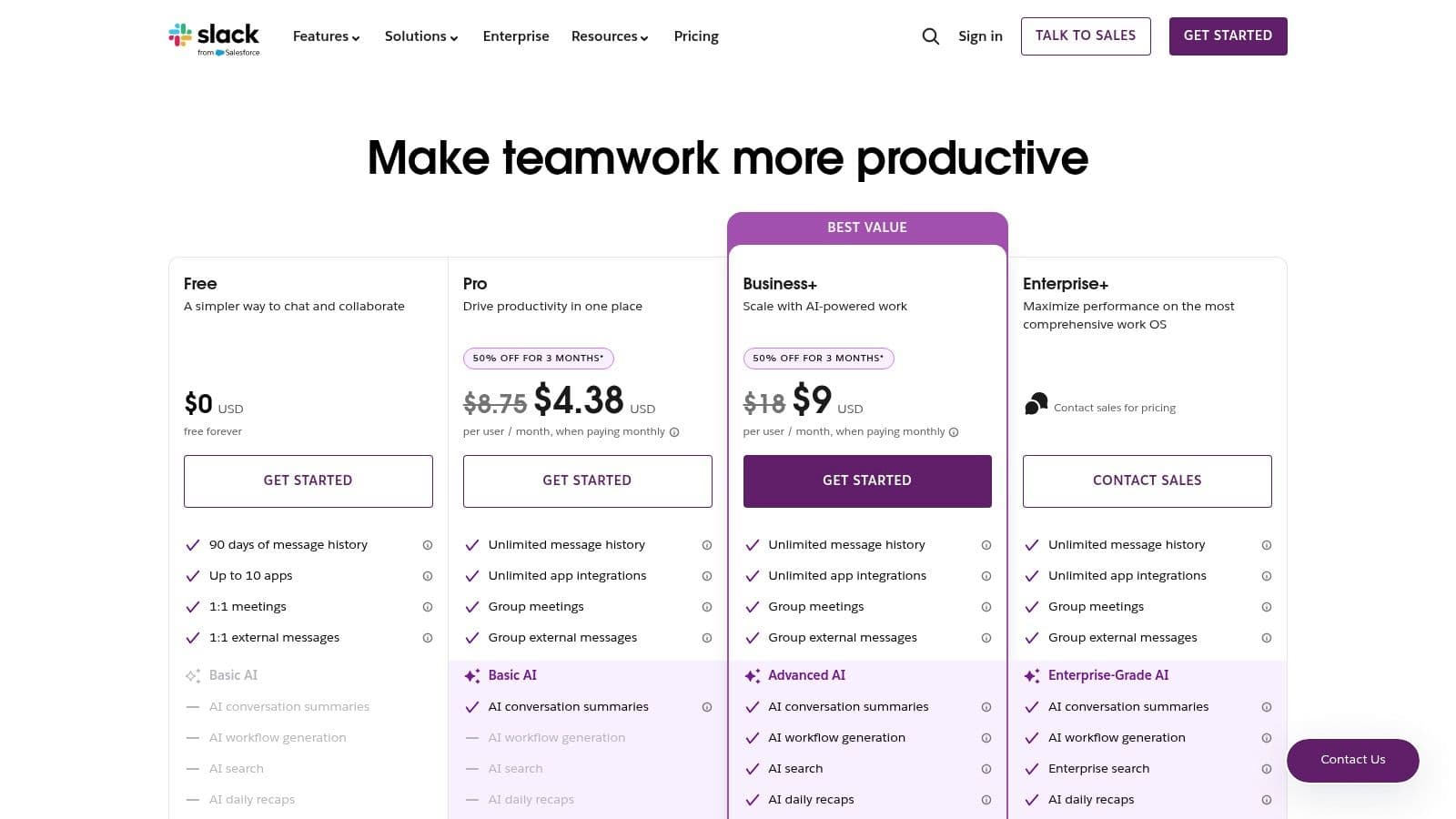
The platform’s core strength is its ability to bring a company’s entire communication stack into one place. Instead of discussions scattered across endless email chains, Slack uses dedicated channels for everything from project kickoffs (#proj-website-redesign) to team-specific updates (#marketing-team) and social chatter (#random). This setup drastically cuts down on internal email and keeps conversations focused and easy to follow.
Key Differentiators and Use Cases
What really sets Slack apart is its massive integration ecosystem. With thousands of apps available, teams can connect tools like Google Drive, Asana, and Jira directly into their channels. This lets you create powerful workflows, like getting automatic notifications for new tasks or sharing document updates without ever leaving the Slack interface.
Another great feature is Slack Connect, which extends the channel-based model to external partners. You can create a shared channel with clients, vendors, or agencies, allowing for real-time collaboration that skips the delays of traditional email. This is a game-changer for projects that need tight coordination with outside organizations.
Expert Tip: To keep channels from getting out of control, set up clear naming conventions (e.g.,
proj-for projects,team-for departments) and regularly archive inactive ones. This helps everyone stay focused and makes information easier to find.
Pricing and Getting Started
Slack offers a few different pricing tiers to suit different needs:
- Free Plan: Great for small teams, offering 90 days of message history and up to 10 app integrations.
- Pro Plan: Starts at $8.75 per user/month (billed annually) and gives you unlimited message history, unlimited integrations, and audio/video huddles with screen sharing.
- Business+ Plan: Begins at $15 per user/month (billed annually) and adds advanced security features like SAML-based single sign-on and data exports for all messages.
The user interface is widely praised for being intuitive, making it relatively easy to get started. But successfully using Slack is about more than just creating an account; it requires a cultural shift in how your team communicates. Setting clear guidelines is a key part of mastering workplace communication skills and is crucial for success.
Learn more at slack.com
3. Microsoft Teams (and Microsoft 365 for Business)
For organizations already deep in the Microsoft ecosystem, Teams is a natural and powerful choice among the top alternatives to email. It's more than just a chat app; it bundles channels, video meetings, file storage, and collaborative app features into a single hub. This unified platform is designed to consolidate internal communication, moving conversations out of siloed inboxes and into transparent, project-based channels.
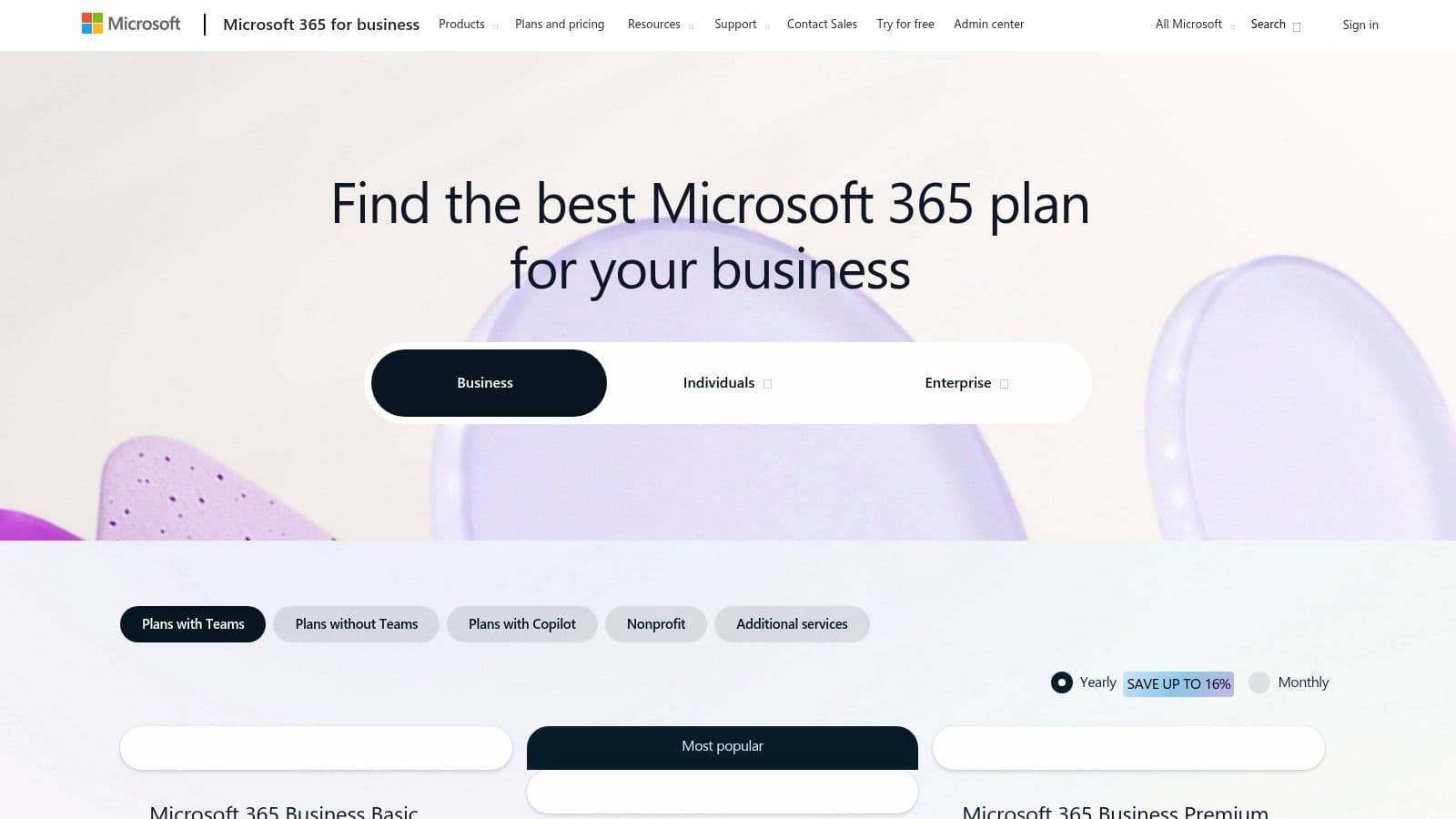
The biggest advantage of Teams is how seamlessly it integrates with the Microsoft 365 suite. Documents created in Word, Excel, or PowerPoint can be co-authored in real-time right inside a Teams channel, which means no more emailing file versions back and forth. All files shared in a channel are automatically saved to a corresponding SharePoint folder, creating a single source of truth for every project and cutting down on scattered email attachments.
Key Differentiators and Use Cases
Microsoft Teams really shines as an all-in-one collaboration hub, especially for organizations that care a lot about security and compliance. Its enterprise-grade security, identity management, and strong administrative controls make it a go-to choice for regulated industries. The platform also connects smoothly with Outlook, letting users share an email conversation directly to a Teams channel to continue the discussion in a more collaborative way.
A major differentiator is its tight connection to the broader Microsoft 365 world. This enables some powerful workflows, like creating a team-wide calendar, setting up a shared OneNote notebook for meeting minutes, or building automated processes with Power Automate—all within the Teams interface. For remote and hybrid teams, this consolidation is invaluable, as highlighted in best practices on how to manage virtual teams.
Expert Tip: Use the "Tabs" feature at the top of each channel to pin frequently used apps, files, or websites. You can pin a specific Excel spreadsheet for a project budget or a Planner board for task tracking, giving everyone instant access without needing to search.
Pricing and Getting Started
Microsoft bundles Teams with its Microsoft 365 for Business plans, making it a cheap add-on for existing subscribers.
- Microsoft Teams (free): Offers unlimited chat, video calls for up to 60 minutes, and 5 GB of cloud storage per user.
- Microsoft 365 Business Basic: Starts at $6.00 per user/month (with an annual commitment) and includes the full Teams experience, web and mobile versions of Office apps, and 1 TB of cloud storage.
- Microsoft 365 Business Standard: Begins at $12.50 per user/month (with an annual commitment) and adds desktop versions of Office apps and webinar hosting.
While powerful, the user interface can feel more complex than some competitors because it has so many features. Getting everyone on board often requires some structured training and clear rules, but for companies invested in the Microsoft stack, its ability to centralize work and communication is unmatched.
Learn more at microsoft.com
4. Google Chat (via Google Workspace)
For companies that live and breathe Google, Google Chat is a seamless and powerful alternative to email for everyday team communication. It moves collaborative work out of cluttered Gmail inboxes and into a more organized, real-time space. Conversations happen in dedicated "Spaces," which are basically topic-based rooms where teams can share files, assign tasks, and hold threaded discussions.
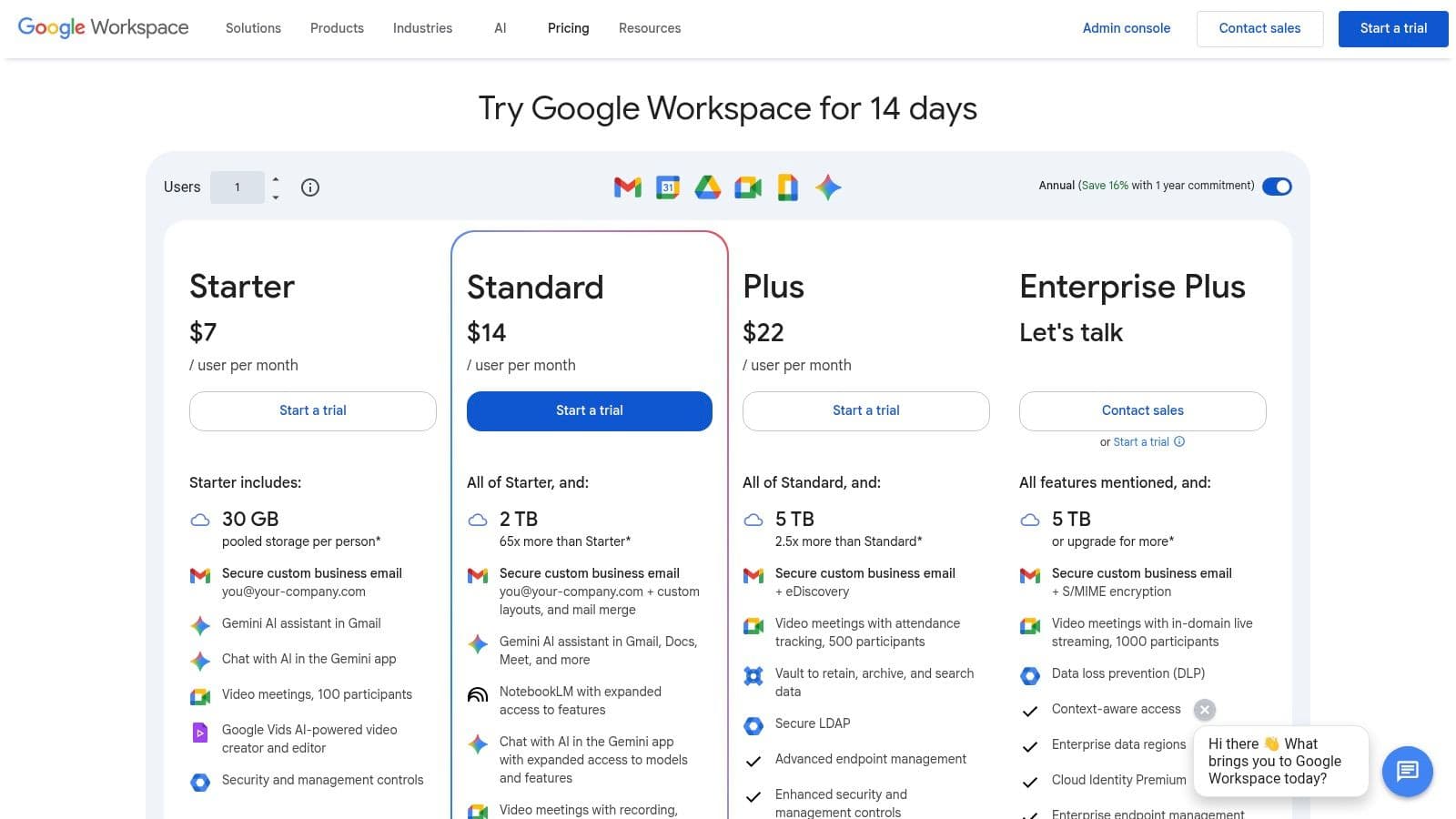
The platform’s main benefit is its native integration within Google Workspace. Instead of being a separate app, Chat is woven right into tools like Gmail, Docs, and Meet. This unified experience lets teams jump from a chat to a video call with one click, collaborate on a Google Doc directly within a Space, and manage conversations without constantly switching between apps. This deep integration really streamlines workflows and reduces the pain of context switching.
Key Differentiators and Use Cases
Google Chat's biggest selling point is its consolidation within the Workspace suite, which makes it an incredibly convenient choice for existing users. The ability to create tasks from messages and manage shared files from Google Drive within a Space keeps projects organized and actionable. All the content is searchable, creating a lasting record of team decisions and discussions that's way more transparent than fragmented email chains.
On top of that, higher-tier Workspace plans infuse Google Chat with AI capabilities through Gemini. This can help summarize long conversations, draft responses, and even automate simple tasks, making it a smarter communication hub. The platform also benefits from the strong security, compliance, and centralized admin features of Google Workspace, giving companies enterprise-grade control over their data.
Expert Tip: Use Spaces for ongoing projects and group chats for short-term or quick discussions. Pin important messages and files to the top of a Space to make sure everyone can quickly find key information without having to scroll through the whole conversation history.
Pricing and Getting Started
Google Chat isn't sold as a standalone product; it's included with all Google Workspace plans. This makes its pricing highly competitive for businesses looking for an all-in-one solution.
- Business Starter: Starts at $6 per user/month and includes Chat along with professional Gmail, 30 GB of storage, and standard versions of Workspace apps.
- Business Standard: Begins at $12 per user/month, bumping storage up to 2 TB and adding meeting recording features.
- Business Plus: Priced at $18 per user/month, this plan adds enhanced security features like Vault and advanced endpoint management.
Because of its familiar, Gmail-like interface, getting started is super smooth for teams already using Google's tools. The key to making it work is to actively encourage teams to create dedicated Spaces for projects and topics, establishing a clear channel for communication that moves work out of individual inboxes and into a collaborative space.
Learn more at workspace.google.com/pricing
5. Mattermost
For organizations where security and data control are everything, Mattermost stands out as a strong open-source alternative to email. It's built for technical and operational teams that need a high level of privacy, compliance, and customization. Mattermost uses the same channel-based communication model as its SaaS competitors but gives organizations complete control over their data by supporting self-hosted and even air-gapped deployments.
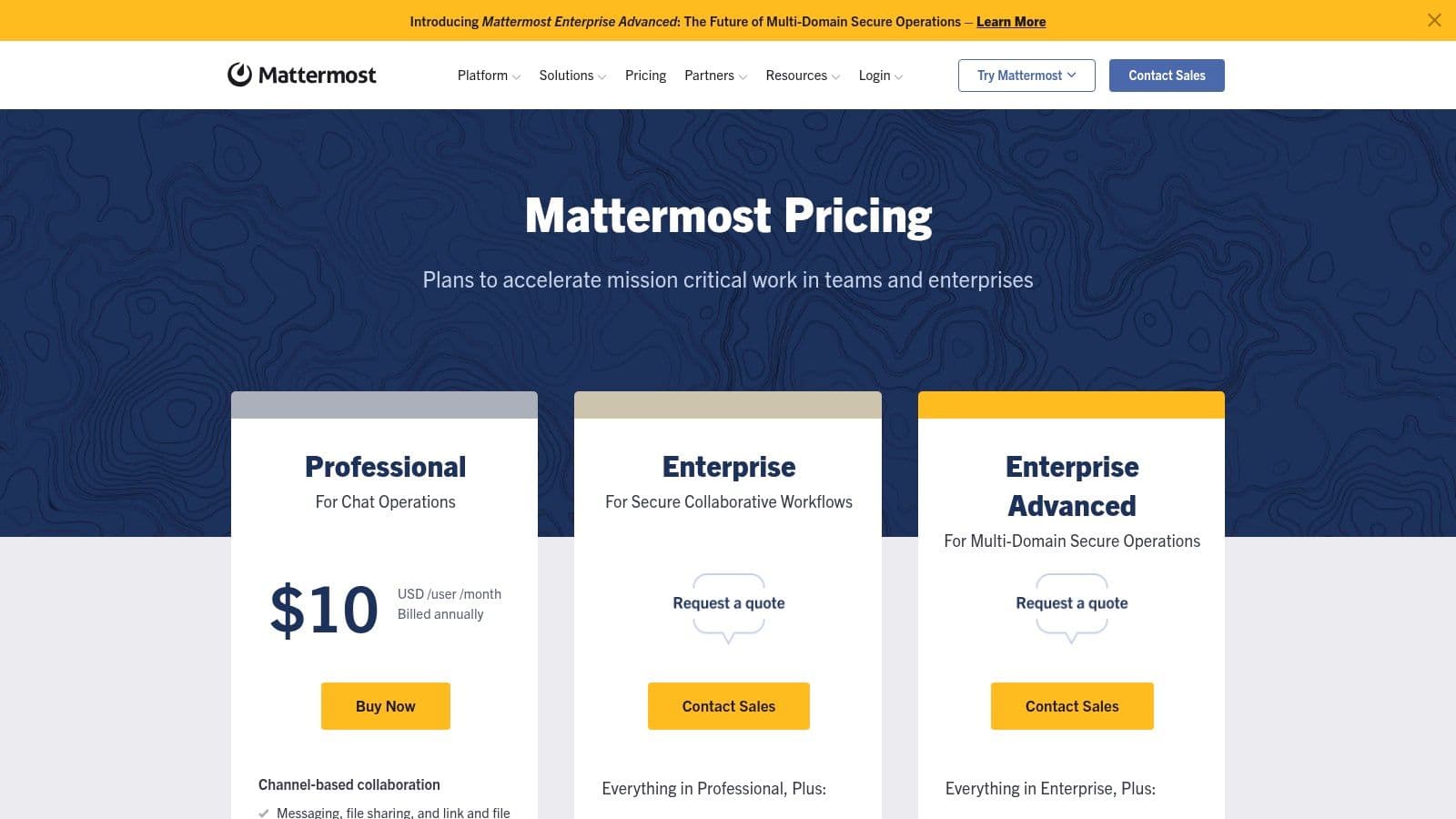
The platform’s main appeal is its ability to serve as a secure command center, making it a great choice for industries like government, defense, and finance. By replacing internal email threads with organized, private channels, it streamlines mission-critical communication. Discussions, files, and workflows are all contained within a secure environment that the organization manages itself, ensuring compliance with strict data rules like GDPR and HIPAA.
Key Differentiators and Use Cases
Mattermost's key differentiator is its self-managed, open-source architecture. This provides a level of control and flexibility you just can't get anywhere else. Organizations can deploy it on their own private cloud or on-premises servers, completely cutting it off from the public internet if needed. This is crucial for air-gapped networks where commercial SaaS solutions are a no-go.
Its open-source nature means you can customize it deeply, from branding the user interface to building custom integrations and plugins. The platform also offers detailed permissions and role-based access controls, along with integrations for SSO and LDAP/Active Directory. This makes it perfect for large companies with complex user management and security needs. For development teams, its integrations with tools like Jira, GitHub, and Jenkins create a powerful DevOps collaboration hub.
Expert Tip: Take advantage of Mattermost's webhook and API capabilities to integrate it with your internal systems. You can create custom slash commands or bots to automate routine tasks, like pulling server status reports or deploying code directly from a chat channel.
Pricing and Getting Started
Mattermost offers several deployment options to fit different scales and security needs:
- Free (Self-Managed): A free-forever edition for teams of up to 50 users, offering core collaboration features like unlimited channels, message history, and integrations.
- Professional (Self-Managed): Starts at $10 per user/month and adds advanced access control policies, multi-factor authentication, and next-business-day support.
- Enterprise (Self-Managed): Custom pricing for large-scale deployments, providing high-availability support, compliance exports, and advanced performance monitoring.
While the user interface is clean and will feel familiar to anyone who's used a modern chat app, the setup and maintenance effort is higher than for cloud-based alternatives to email. Successfully deploying Mattermost requires dedicated IT resources and technical know-how. But for organizations that absolutely cannot compromise on security or data ownership, the investment delivers an unparalleled degree of control over their communication.
Learn more at mattermost.com/pricing
6. Rocket.Chat
For organizations that put a high value on data sovereignty, security, and open-source flexibility, Rocket.Chat is a really solid alternative to email. It offers a robust, self-hostable communication platform that gives businesses complete control over their data—a critical feature for sectors like government, healthcare, and finance. The platform shifts internal and external conversations from isolated email inboxes into a secure, real-time messaging environment.
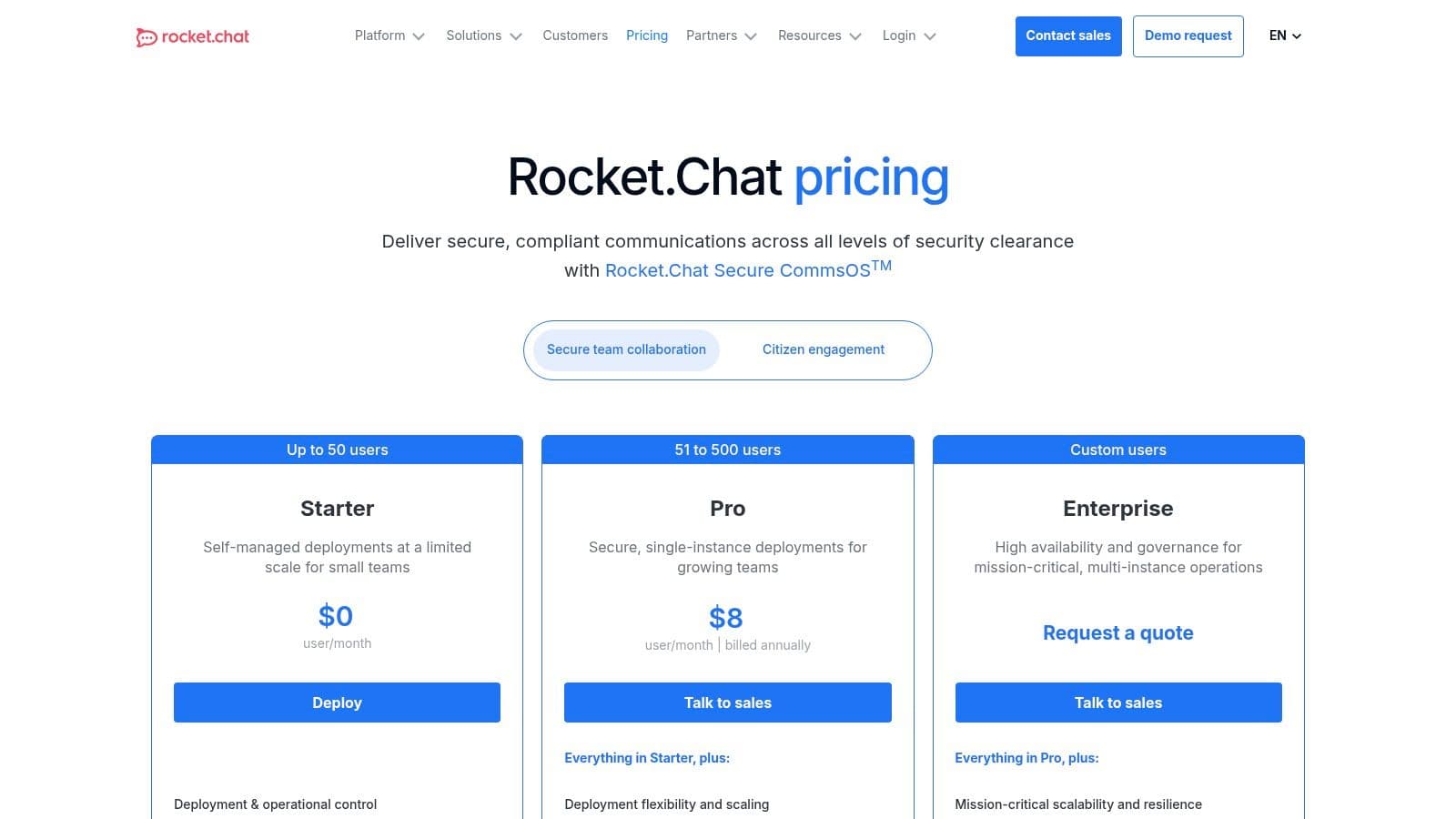
Rocket.Chat’s main value is its deployment flexibility. Unlike many pure SaaS options, it can be deployed on-premise or in a private cloud, including in air-gapped networks. This ensures that sensitive communications never leave the organization's control. It supports familiar features like public and private channels, direct messages, and threaded conversations, centralizing project discussions and team updates in one transparent, searchable place.
Key Differentiators and Use Cases
The platform's open-source nature is its biggest differentiator, allowing for deep customization and white-labeling to match a company's brand. It also supports federation via the Matrix protocol, which allows for secure communication with users on different servers or even entirely different platforms. One standout feature is its native federation with Microsoft Teams, which bridges communication gaps between organizations using different ecosystems without having to fall back on email.
On top of that, Rocket.Chat goes beyond internal team chat with its omnichannel capabilities. It can pull customer service communications from sources like live chat, WhatsApp, and social media directly into the platform, letting support teams manage all conversations from a single interface. This is a huge plus for businesses looking to unify internal collaboration with external customer engagement.
Expert Tip: When self-hosting Rocket.Chat, invest time in setting up security features like SSO/LDAP integration and multi-factor authentication from the get-go. This makes sure your deployment meets enterprise-grade security standards and simplifies user management.
Pricing and Getting Started
Rocket.Chat provides several tiers, including a generous free option for self-hosted deployments:
- Community (Free): A self-managed plan that is ideal for teams wanting full control and access to core features without a subscription cost.
- Pro Plan: Starts at $7 per user/month (billed annually) and includes premium features like advanced security controls, omnichannel integrations, and enterprise-grade support.
- Enterprise Plan: Custom pricing for large organizations requiring scalability, advanced compliance features like data loss prevention, and dedicated deployment support.
While the user interface is clean and functional, the administrative side of self-hosted versions can be more complex than turnkey SaaS solutions. However, for organizations with the technical resources, Rocket.Chat offers an unmatched level of control, security, and customization as a powerful replacement for traditional email workflows.
Learn more at rocket.chat/pricing
7. Discord
Originally built for gaming communities, Discord has grown into a powerful and versatile communication hub, making it a surprisingly good alternative to email for many modern teams. It swaps out disjointed email threads for persistent, server-based communication where conversations are organized into dedicated text and voice channels. This structure fosters a more fluid, real-time environment that's perfect for startups, developer communities, and creative teams.
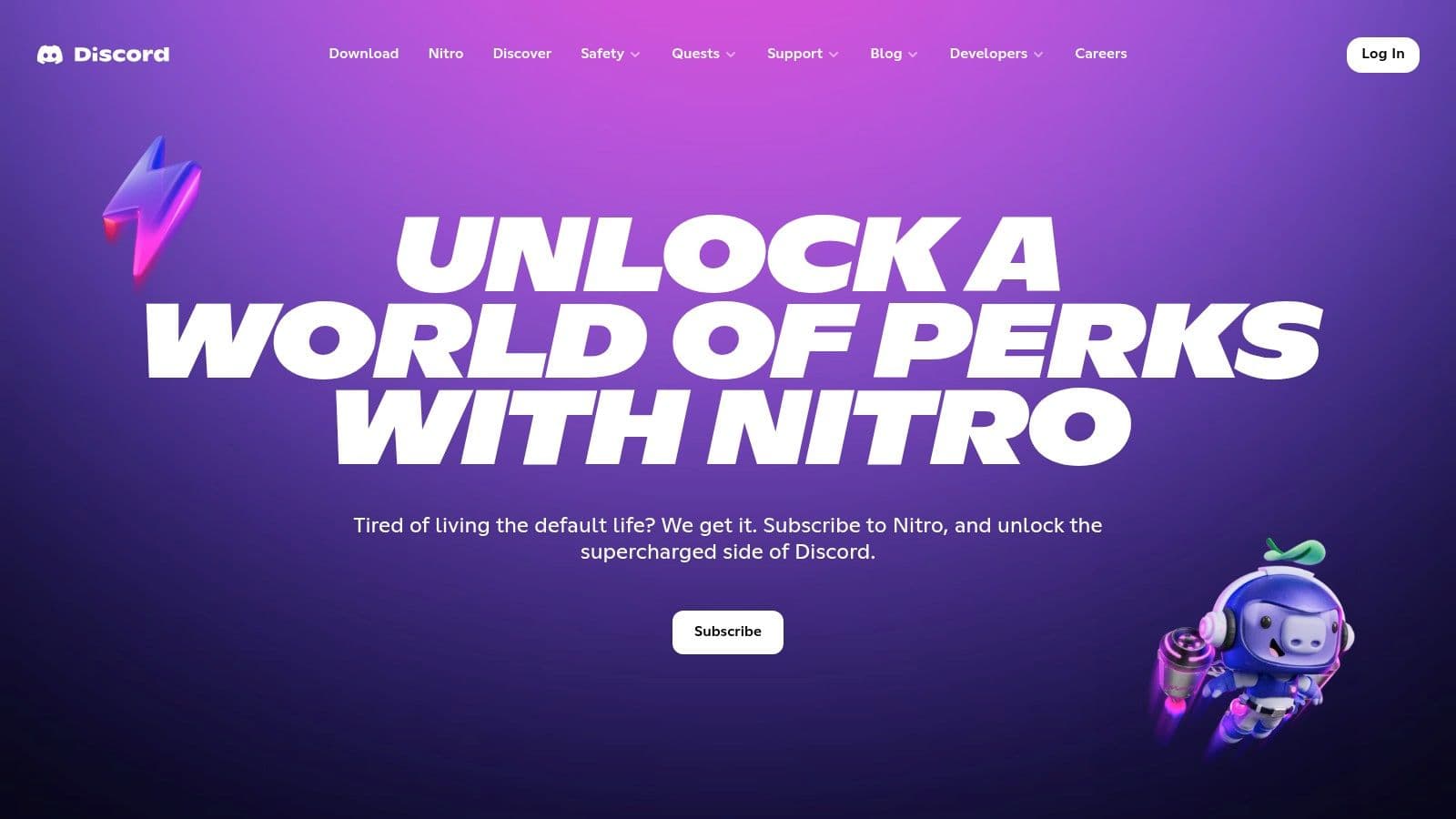
The platform's strength is its "always-on" feel, combining text chat with seamless, drop-in voice and video rooms. Instead of scheduling a formal meeting, team members can just jump into a voice channel for a quick discussion. This immediacy breaks down communication barriers and is especially effective for distributed teams that need to collaborate on the fly, making it one of the most dynamic virtual team collaboration tools out there.
Key Differentiators and Use Cases
What really sets Discord apart is its robust community management toolset and its incredibly generous free offering. Unlike more corporate-focused platforms, Discord is amazing at building both internal team culture and external communities of users or fans. The ability to assign detailed roles and permissions allows for sophisticated server organization, giving different members access to specific channels and privileges.
Another standout feature is its high-quality, low-latency voice communication, a direct result of its gaming origins. This makes it better for teams that rely heavily on voice chat for things like pair programming, design reviews, or brainstorming sessions. The platform also supports server events, threads for focused side-conversations, and a growing number of integrations (bots) that can automate tasks and bring information directly into your server.
Expert Tip: Use the "Roles" feature to manage permissions and create private channels for specific projects or leadership discussions. For example, assign a
@Project-Leadsrole to give key members access to a#project-planningchannel.
Pricing and Getting Started
Discord's pricing is extremely accessible, making it a frictionless choice for startups and volunteer-run organizations.
- Free Plan: The core experience is completely free, offering unlimited servers, channels, members, and messages with no history limits. This is a huge advantage over competitors.
- Nitro: Starts at $2.99 per month for Nitro Basic or $9.99 per month for the full Nitro plan. These are individual user upgrades that improve the experience with larger file uploads, custom emojis, and HD video streaming. Server boosts are also available to unlock perks for an entire server community.
Getting started is remarkably easy due to its intuitive, consumer-friendly interface. However, its strength in community building means it's missing some of the enterprise-grade security and compliance features found in platforms like Slack or Microsoft Teams, such as advanced data exports or SSO on its free tier. It is best suited for teams that value flexibility and real-time interaction over strict corporate governance.
Learn more at discord.com/nitro
Alternative Communication Tools Comparison
| Platform | Implementation Complexity 🔄 | Resource Requirements ⚡ | Expected Outcomes 📊 | Ideal Use Cases 💡 | Key Advantages ⭐ |
|---|---|---|---|---|---|
| Fluidwave | Moderate; varied task views and AI features require learning | Low to moderate; no subscription fees, pay-per-task outsourcing | Increased productivity with 4+ hours saved weekly, better task focus | Busy professionals, teams needing AI-driven task automation and delegation | AI auto-prioritization, flexible views, pay-per-task virtual assistant model |
| Slack | Low to moderate; mostly SaaS setup | Moderate; costs scale with team size | Streamlined team and external communication with reduced email overload | Teams prioritizing integrations, external collaboration, and messaging | Best-in-class integrations, Slack Connect for external partners, strong security |
| Microsoft Teams | Moderate to high; complex UI and settings | Moderate to high; leverages existing Microsoft 365 licenses | Enhanced internal collaboration with file sharing and enterprise security | Organizations already using Microsoft 365, regulated sectors | Deep Microsoft 365 integration, enterprise-grade security, and management |
| Google Chat | Low; integrated in Workspace ecosystem | Low to moderate; included with Workspace plans | Efficient task and communication management within Google Workspace | Businesses using Google Workspace seeking integrated chat and collaboration | Seamless Workspace app integration, competitive pricing |
| Mattermost | High; self-hosted and customizable | High; self-managed infrastructure and maintenance | Secure, compliant collaboration in controlled environments | Organizations needing compliance, data sovereignty, and on-premises hosting | Open-source customization, strong compliance and security controls |
| Rocket.Chat | High; self-hosted with complex admin | Moderate to high; flexible deployment options | Secure, customizable messaging with compliance features | Public sector, healthcare, enterprises needing strict data controls | Flexible deployment, free starter tier, MS Teams federation |
| Discord | Low; easy onboarding and free core version | Low; free with optional paid Nitro for upgrades | Persistent, always-on conversational platform | Startups, developer communities, creatives seeking informal collaboration | Frictionless onboarding, strong community tools, free core offering |
Choosing the Right Tool to Reclaim Your Focus
The journey away from an overflowing inbox isn't about finding a single, magical app to replace email entirely. The real solution is adopting a modern toolkit where each piece is chosen for a specific purpose. This strategic shift is how you build a more focused, productive, and less reactive work environment. The key is to stop forcing a 50-year-old technology to manage workflows it was never designed for.
We've seen how dedicated chat platforms like Slack and Microsoft Teams are great for real-time conversations, pulling urgent discussions out of long, confusing email threads. We've also covered how self-hosted solutions like Mattermost and Rocket.Chat provide essential security and control for organizations with strict compliance needs. Even a platform like Discord, once seen as just for gamers, offers a unique hub for communities and communication.
But maybe the most important takeaway is recognizing where email fails the most: turning conversation into action. This is where a real paradigm shift is needed.
From Reactive Inbox to Proactive Workflow
The basic problem with using email as a task manager is its lack of structure. Important requests, deadlines, and attachments get buried under an avalanche of newsletters, CCs, and FYI messages. This is the chaos that AI-driven task managers like Fluidwave are built to solve, by providing a dedicated space where work is defined, assigned, and tracked with clarity.
Adopting these powerful alternatives to email takes some intentionality. It’s not about flipping a switch overnight; it's about a gradual, deliberate change in your team’s communication habits. The most successful transitions follow a clear, manageable path.
Your Action Plan for an Email-Free Future
To make this transition work, don't just send out a company-wide memo to "use less email." Instead, start small and be specific. Follow these steps to begin reclaiming your team's focus:
- Identify the Primary Pain Point: What is the biggest frustration with your current email workflow? Is it missed deadlines? Trouble tracking project progress? A constant feeling of being overwhelmed by notifications? Pinpoint the single most damaging issue.
- Select a Pilot Tool for a Specific Use Case: Based on that pain point, pick one tool from this list. If your problem is lost tasks, try out Fluidwave. If it's chaotic team chatter, start a dedicated channel in Slack or Teams.
- Define a Clear, Limited Scope: Launch your pilot with a single team or project. Create a simple, powerful rule. For example: "For the next 30 days, all internal communication and task delegation for 'Project Phoenix' will happen exclusively in our new Fluidwave workspace. Email is only for external client communication."
- Build and Reinforce New Habits: Leadership has to model the new behavior. Consistently redirect conversations back to the new platform. Celebrate wins and gather feedback to show the team that this change is making their work life easier, not more complicated.
By thoughtfully choosing from these modern tools, you're not just finding alternatives to email; you are fundamentally redesigning how work gets done. You're transforming your team's workflow from a reactive, inbox-driven mess into a proactive, organized, and truly collaborative system. This frees up precious mental energy for the deep, focused work that actually drives results and innovation.
Ready to take the first, most impactful step in moving beyond your inbox? Fluidwave is designed to capture the actionable work that gets lost in email chains, using AI to turn chaotic conversations into clear, trackable tasks. See how our platform provides the structure your team needs to achieve true focus and clarity. Explore Fluidwave today.
Focus on What Matters.
Experience lightning-fast task management with AI-powered workflows. Our automation helps busy professionals save 4+ hours weekly.